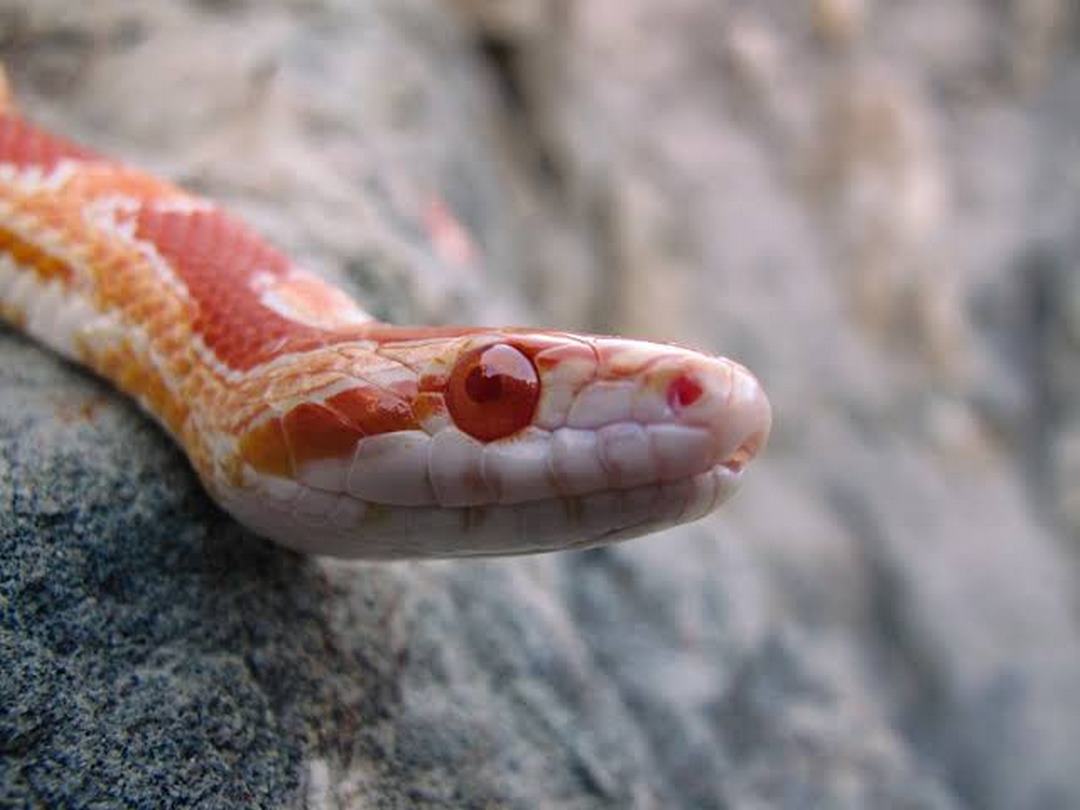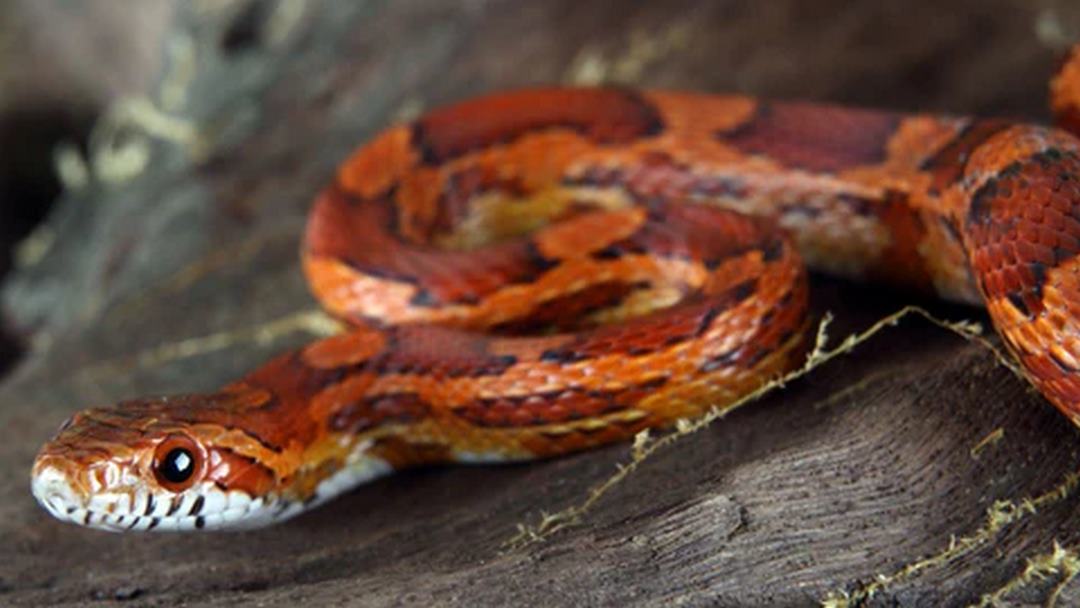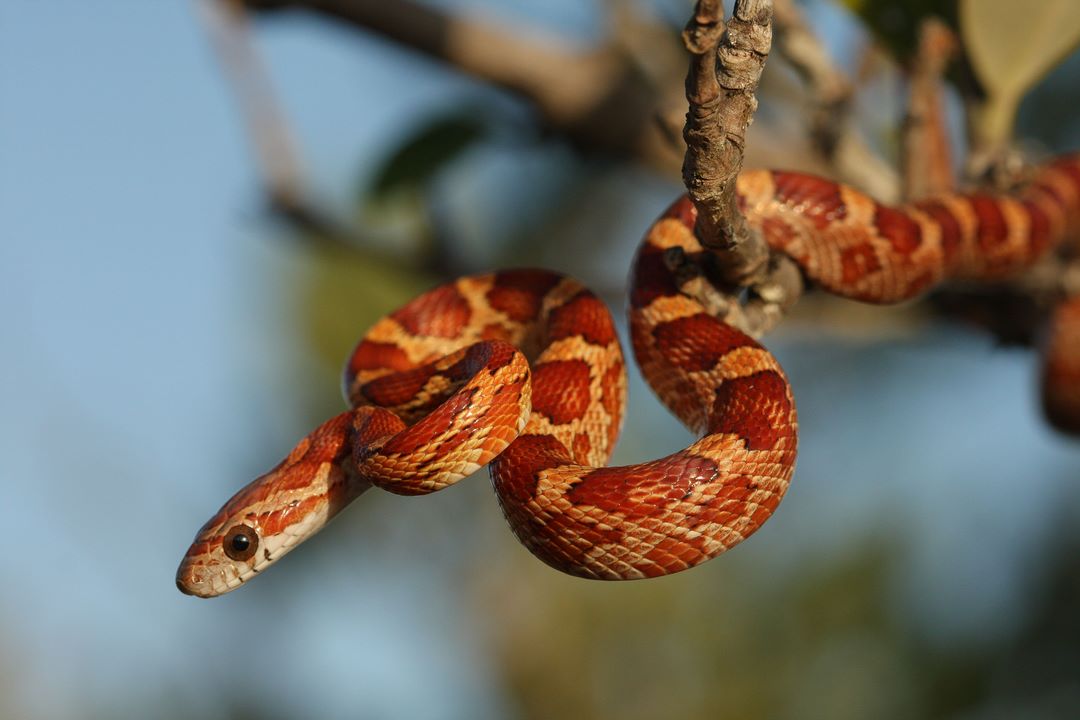The corn snake, scientifically known as Pantherophis guttatus, is a popular pet snake that’s easy to tame. With its beautiful variety of colors, it appeals to many people who want an aesthetically pleasing pet. If you’re thinking about getting a corn snake, it’s essential to research its characteristics, habits, and care needs from reliable sources.
1. Is a Corn Snake Venomous?
Corn snakes are native to the United States, Central America, and the Caribbean islands. They typically live in forests, wetlands, and marshy areas. Despite being a snake, they’re quite docile and non-venomous, making them great pets for families.
Similar to leopard geckos, corn snakes have several advantages, including being easy to care for and having a calm temperament. Their diverse and striking colors are a big draw. One of the greatest benefits of corn snakes is how easily they can be bred in captivity.
In recent years, as pet snakes have become more popular, corn snake breeding has taken off. Many experienced snake owners move on to breeding their pets after mastering basic care, and news of successful breeding efforts continues to spread, exciting enthusiasts. For newcomers to the hobby, though, corn snake breeding remains an intriguing and often complex process.
2. The Corn Snake’s Habitat
When keeping a corn snake as a pet, the first thing to consider is providing a suitable habitat where it can thrive. Corn snakes are sensitive to changes in their environment, and moving them to a new place can make them uneasy, so it’s important to give them time to adjust.
The snake’s enclosure should be about 1.5 times longer than the snake itself. Since they’re sensitive to their surroundings, a calm environment with clean water and places to hide is essential. When you first bring your snake home, avoid handling it too much and don’t feed it right away. Give it at least 3–5 days of peace and quiet, limiting any outside disruptions. Once it’s comfortable in its new home, you can start feeding it. Corn snakes can go a long time without food, so there’s no need to worry. These snakes also prefer warmer environments.
If you want to warm their enclosure, using a heating mat is better than a heat lamp because it’s less likely to cause burns. Make sure to adjust the temperature carefully—if it feels too hot to your hand, it’s likely too hot for the snake as well.
3. What Do Corn Snakes Eat?
In the wild, corn snakes are pretty fast, whether slithering on the ground or climbing. Depending on their size and type, their dietary needs vary, but generally, they feed on insects, bird eggs, frogs, and small mammals.
As pets, their most common food is baby mice, which can be frozen and stored for convenience. When ready to feed, simply thaw the mouse. Be sure not to offer food that’s too large, as it can overwhelm the snake.
While some owners prefer feeding live mice, it’s not always a good idea. Rodents can fight back, potentially injuring or even killing the snake, so it’s best to offer pre-killed food.
4. How to Feed a Corn Snake
Like other reptiles, corn snakes are cold-blooded, meaning their body temperature changes with their environment. Temperature fluctuations can affect their appetite.
Even after a year of captivity, wild-caught corn snakes may retain their natural habits. They might enter a state of dormancy in winter, even if the temperatures in their enclosure don’t drop low enough to require it.
When feeding your snake, you can remove it from its enclosure and place it in a ventilated box to help it focus on eating and avoid ingesting any bedding. It’s also recommended to feed them captive-bred rodents to prevent parasites. Frozen food is safer for corn snakes compared to live prey.
You should feed baby corn snakes every 5–7 days, while adult snakes can be fed every two weeks. The amount of food should match the size of the snake’s stomach—overfeeding can lead to digestion issues, which can be dangerous.
As for water, corn snakes need a water dish large enough for soaking, especially when shedding. Since tap water contains chlorine, which can be harmful, use bottled water or dechlorinate tap water before offering it to your snake. Be sure to change the water at least twice a week to keep it fresh and clean.
5. Setting Up an Enclosure for a Corn Snake
5.1 Preparing the Snake’s Enclosure
Corn snakes are excellent escape artists, so when setting up their enclosure, make sure it’s secure with a well-fitted lid. An adult corn snake can live in a tank with a capacity of around 80 liters, while smaller ones can be housed in 20-40 liter enclosures.
You can also use a simple plastic box as long as it’s large, well-ventilated, and escape-proof. Be sure to add a secure lid with a latch. Including branches in the enclosure can provide the snake with climbing options, which will also help with shedding.
Maintaining the correct temperature inside the enclosure is crucial. A heating pad can be placed under part of the tank to create warm and cool zones, with the ideal temperature around 82°F (28°C). This allows the snake to move between warmer and cooler areas as needed.
5.2 Substrate for the Enclosure
You can use wood shavings, like those used for rabbits or mice, with a layer about 1-2 cm thick. A small cave or hideout can also be added, but it might make handling and taming more difficult. Make sure to provide a sturdy water dish for drinking and soaking, as well as a low-wattage red light for nighttime use.
Alternatively, you can use artificial grass or newspaper as a substrate, which are easy to clean. Avoid using pine shavings, as the oils they contain can be toxic to snakes, especially if they get into their water.
Before bringing your snake home, make sure the enclosure is fully set up with a heat source, water dish, and appropriately sized food. Don’t wait until after you’ve bought the snake to figure these things out.
You can also add non-toxic decorations like rough wood or faux plants to make the enclosure more interesting. Real plants aren’t recommended as they can attract insects, which may harm your snake. Volcanic rock is a great natural option that can add aesthetic appeal and help with shedding.
5.3 Lighting
Some pet stores might tell you that corn snakes need UV light to synthesize vitamins, but this isn’t true. Unlike many reptiles, corn snakes are active in the early morning and late evening, so in the wild, they wouldn’t be exposed to much UV light. They get the nutrients they need from their food, so additional UV lighting is unnecessary.
6. Methods for Cohabiting Corn Snakes
Corn snakes are relatively independent creatures, and under normal circumstances, they live solitary lives. They only seek out a mate during the breeding season. If different species of snakes are kept together, there’s a high risk of cannibalism.
It is highly recommended to avoid housing different snake species together in the same enclosure. Young corn snakes do not mind smaller living spaces, and a 40x20x50 cm tank is sufficient. The key is to ensure they have their own space and avoid constantly seeking company for them.
7. Corn Snake Breeding Care
7.1 Breeding Age for Corn Snakes
Corn snakes typically reach sexual maturity between 6 months and 2 years old. During the breeding season, which occurs annually, a male can mate with several females. Although the female snake only mates once, sperm is stored in her cloaca and can remain viable for up to 3 years. This means a male-to-female ratio of 1:8 is adequate.
The breeding season for corn snakes typically occurs from March to May. Females lay eggs once per year, with each clutch containing between 30 and 40 eggs. The incubation period is around 60 to 65 days, and the eggs usually hatch from July to September.
The gender of the hatchlings, like most reptiles, is determined by temperature. Higher temperatures result in more males, while lower temperatures lead to more females. The average lifespan of corn snakes is 12 to 15 years, though some can live as long as 23 years.
7.2 Selecting Breeding Corn Snakes
When selecting a female corn snake for breeding, it’s advisable to choose those weighing at least 200 grams. For males, the weight standard is slightly more flexible, but they should weigh a minimum of 150 grams.
It’s not recommended to breed corn snakes below the weight threshold, as their physiological functions may not be fully developed. Corn snakes underweight are more prone to complications, including potential issues like egg binding.
The best substrate for egg-laying is vermiculite, a popular medium for its water retention properties, maintaining moisture levels without the risk of mold, and keeping the eggs clean.
7.3 Egg Care After Laying
After the eggs are laid, it is crucial to prepare the vermiculite. If you don’t have time to sterilize it with boiling water and sun-dry it for 1–2 days, you can roast it lightly in a pan to disinfect it. Be sure to remove excess water before placing the eggs in the medium, as too much moisture can be harmful.
When the eggs are laid, gently mark the top with a pencil or marker without damaging them, then half-bury them in vermiculite, ensuring the marked side remains upright. The box containing the eggs should be monitored regularly, with water sprayed every 2–3 days to maintain humidity between 75% and 90%. Ensure the temperature stays at least 26°C.
7.4 Key Points During Corn Snake Breeding
Breeding preparation should start when the snakes are young. Particularly for males, avoid overfeeding to ensure a longer growth period, allowing their reproductive systems to develop fully. After the low-temperature season ends, introduce the male to the female’s enclosure. Once mating is confirmed, separate them.
After egg-laying, the female should be fed nutritious meals to restore her energy. Avoid excessive handling of the eggs and check for any damaged or infertile eggs, removing them immediately.
8. Caring for a Shedding Corn Snake
8.1 Causes of Shedding Difficulties
Unlike other animals, snakes must shed their skin as their bodies grow, a process where the old skin peels away to reveal a new, elastic layer. Issues in shedding often arise when the humidity in the enclosure is too low, particularly in colder, drier environments. Incomplete shedding can lead to dehydration and potential infections.
To help, you can use weak adhesive tape to gently remove any stuck pieces of skin. Avoid interfering too early in the shedding process, as this could cause the new skin to become swollen.
8.2 Assisting Corn Snakes During Shedding
Snakes typically shed every few months. Prior to shedding, their color may dull, and their eyes may turn gray or blue. About 3–4 days before shedding, their eyes will clear up, and they may start rubbing against surfaces, signaling that shedding is about to begin.
You can assist by placing damp towels or moss in their enclosure to help soften the skin. After the shed, inspect the snake to ensure all old skin has been removed to prevent any complications.
9. Managing Regurgitation in Corn Snakes
9.1 Psychological Causes of Regurgitation
One common reason for regurgitation in corn snakes is stress. Many corn snakes sold at pet stores are very young and sensitive. After long transport without food or water, overfeeding can cause digestive issues, leading to regurgitation.
Corn snakes need rest after feeding, typically taking about a week to digest their meal. Immediately handling them or causing stress can trigger regurgitation.
9.2 Dietary Causes of Regurgitation
Corn snakes typically eat small rodents like mice, frogs, or lizards. Feeding them large prey or too frequently can lead to regurgitation as their digestive systems become overwhelmed. The prey size should match the snake’s size, and meals should be spaced appropriately.
9.3 How to Treat Regurgitation in Corn Snakes
After a snake regurgitates, refrain from feeding them immediately. The regurgitation process can cause damage to the stomach and throat, so give the snake 7–10 days to recover before attempting to feed again.
When reintroducing food, offer smaller prey items to ease the digestive system back into function.
10. Caring for Injured or Sick Corn Snakes
10.1 Respiratory Infections in Corn Snakes
Corn snakes are prone to respiratory infections, particularly in poor conditions where temperatures are too low, ventilation is poor, or humidity is too high. Symptoms include open-mouth breathing, sneezing, and mucus discharge. If you suspect a respiratory infection, consult a vet immediately.
10.2 Treating External Injuries
Corn snakes kept indoors are generally safe from harm, but if they suffer from cuts or abrasions, clean the wound with diluted soap or saline, dry it gently, and apply a thin layer of antibiotic ointment. Most human-grade antibiotics are safe for corn snakes.
10.3 Corn Snake Refusing Food
It is common for newly acquired corn snakes to refuse food, especially in the first few days. Allow them time to adjust to their environment, and avoid disturbing them while feeding. If they refuse to eat, wait 48 hours before offering food again.
Corn snakes can thrive with minimal handling, unlike pets like dogs or cats, and should be left in peace to develop healthily.
11. Important Considerations for Corn Snake Care
11.1 Diet Considerations
While corn snakes primarily feed on small rodents, you can occasionally offer other prey like frogs. Their enclosure should be large enough to accommodate at least ¾ of the snake’s body length, and a ventilated tank is essential for good airflow. Always ensure the enclosure is securely locked to prevent escapes.
11.2 Temperature and Humidity
Corn snakes thrive at temperatures between 21–31°C, with a humidity level of 75–80%. During shedding, avoid disturbing them and ensure the enclosure is dry to prevent scale damage.
11.3 Enclosure Hygiene
Clean the enclosure regularly, particularly after feeding, to prevent bacterial growth. A well-maintained environment is crucial for their health, reducing the risk of infections.





